Digital Poster
Strategic Acquisitions II
Joint Annual Meeting ISMRM-ESMRMB & ISMRT 31st Annual Meeting • 07-12 May 2022 • London, UK

| Computer # | ||||
|---|---|---|---|---|
2444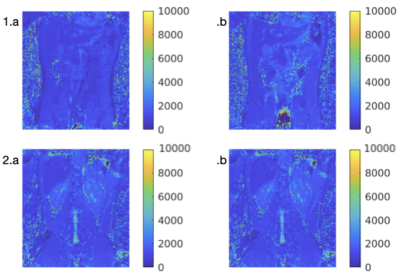 |
73 | Abdominal 3D-T1-weighted imaging with the radial MP2RAGE sequence.
François Emmanuel Jean Guy MAINGAULT1, Nadège CORBIN1, William LEFRANÇOIS1, Aurélien J TROTIER1, Sylvain MIRAUX1, and Emeline J RIBOT1
1Centre de Résonance Magnétique des Systèmes Biologiques, UMR5536, CNRS, Bordeaux, France, Metropolitan The Magnetization Prepared Two RApid Gradient Echo (MP2RAGE) sequence with a cartesian sampling is performed to obtain 3D-T1 weighted images of the brain. A radial encoding giving a better robustness to respiratory motion has been implemented in order to use the MP2RAGE sequence for abdominal imaging. |
||
2445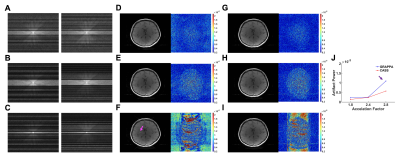 |
74 | Calibration kernels with Alternative Sampling Scheme (CASS) for Parallel Imaging: SENSE meets CASS
Sangcheon Choi1,2, Rahel Heule1,3, Edyta Leks1,2,3, Felix Glang1, Xin Yu4, and Klaus Scheffler1,3
1Department of High-field Magnetic Resonance, Max Planck Institute for Biological Cybernetics, Tuebingen, Germany, 2Graduate Training Centre of Neuroscience, University of Tuebingen, Tuebingen, Germany, 3Department of Biomedical Magnetic Resonance, University of Tuebingen, Tuebingen, Germany, 4Athinoula A. Martinos Center for Biomedical Imaging, Department of Radiology, Harvard Medical School, Massachusetts General Hospital, Charlestown, MA, United States
We developed new calibration kernels with an alternative undersampling scheme (CASS) for parallel imaging to reduce coherent aliasing artifacts and noises. By sampling k-space lines with irregular and blockwise patterns, incoherent aliasing patterns and noise signals were spread in reconstructed CASS images. Noteworthily, the CASS method outperformed the conventional GRAPPA method at higher acceleration factors.
|
||
2446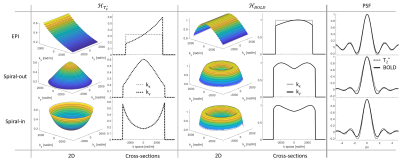 |
75 | BOLD PSF: Impact of k-space sampling on T2* contrast
Maria Engel1, Lars Kasper1,2, and Klaas Paul Pruessmann1
1Institute for Biomedical Engineering, ETH Zurich and University of Zurich, Zurich, Switzerland, 2Translational Neuromodeling Unit, Institute for Biomedical Engineering, University of Zurich and ETH Zurich, Zurich, Switzerland The timing of BOLD-fMRI is typically chosen such that TE matches T2*. This assumes contrast being exclusively elicited by signal differences at TE. While sensible for short or TE-symmetric readouts, such as EPIs, it oversimplifies contrast generation for longer or TE-asymmetric trajectories, such as spirals. We propose the concept of a BOLD PSF for a more comprehensive perspective on the imaging characteristics of a functional experiment. Our findings indicate that TE can be reduced for spiral-out without sacrificing BOLD-sensitivity when compared to EPI. Furthermore, we characterize the intrinsic trade-off between specificity and resolution of the BOLD response under varying TE. |
||
2447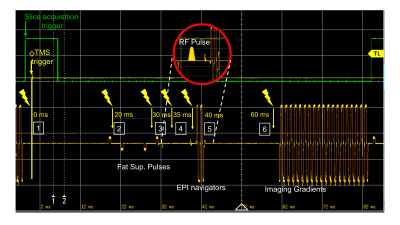 |
76 | Synchronizing TMS pulses for free artifact fMRI for multichannel TMS systems using the integrated whole head TMSMR 28 channel RF coil array
Lucia Navarro de Lara1,2, Isil Uluc1,3, Qinglei Meng1,3, Jason Stockmann1,3, Larry Wald1,3, and Aapo Nummenmaa1,3
1Martinos Center - MGH, Charlestown, MA, United States, 2Harvard Medical School, Boton, MA, United States, 3Harvard Medical School, Boston, MA, United States
For TMS/fMRI experiments, to acquire functional images without artifacts, general recommendations have been proposed. In order to apply TMS pulses in a multichannel Transcranial Magnetic Stimulation system integrated with the new constructed TMSMR 28- channel RF coil, we have explored the different options and artifacts that can be generated depending on when the TMS pulses are applied with respect to the sequence timing. As conclusion, we propose a method using an RF pick up loop to assure that the delivery of the TMS pulses are not close to the EPI navigators or the imaging gradients.
|
||
2448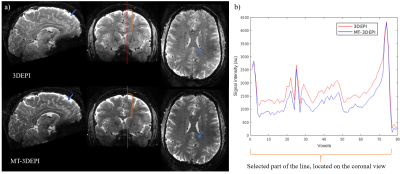 |
77 | Magnetization transfer optimization to enhance 3D EPI image contrast for high-resolution fMRI applications at 7T
Vahid Malekian1, Nadine N. Graedel1, Oliver Josephs1, and Martina F. Callaghan1
1Wellcome Centre for Human Neuroimaging, UCL Queen Square Institute of Neurology, University College London, London, United Kingdom 3DEPI is widely used for cortical depth-dependent fMRI studies at 7T. However, it suffers from poor image contrast that can be problematic for fMRI post-processing steps. One solution to bolster contrast is to implement a magnetization transfer (MT) module. Here, we experimentally investigated the different MT pre-pulse characteristics to optimize image contrast, while considering power limitations at 7T. Contrast gains eased co-registration to an MP2RAGE reference, and improved cortical segmentation. Our analyses confirmed that the MT contrast is spatially variable and dependent on transmit field inhomogeneity.
|
||
2449 |
78 | Millimeter Spatial Resolution and Subsecond Temporal Resolution in Real-Time fMRI using Multi-Band Echo-Volumar Imaging
Stefan Posse1, Sudhir Ramanna2, Steen Moeller2, Bruno Sa De La Rocque Guimaraes1, Michael Mullen2, and Essa Yacoub2
1Neurology, U New Mexico, Albuquerque, NM, United States, 2Center for Magnetic Resonance Research, Minneapolis, MN, United States
In this study we develop highly undersampled multi-band slab-segmented echo-volumar imaging (MB_EVI), which combines the sampling efficiency of single-shot 3D encoding with the sensitivity advantage of multi-echo acquisition, and explore the feasibility of shortening the readout duration using segmented within-slab slice encoding. Kz-segmented Segmented MB-EVI enabled a nominal 1x1x1 mm isotropic voxel size with 64 slices and a temporal resolution of 618 ms with sub-second acquisition time.
|
||
2450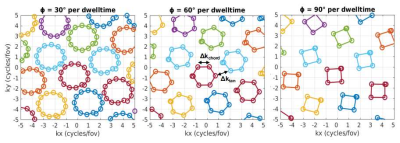 |
79 | Optimal Parameter Selection for 3D Radial Density Adapted Trajectories
Mark Bydder1, Fadil Ali1, Andres Saucedo1, Chencai Wang1, Akifumi Hagiwara1, Alex D Pham1, Jingwen Yao2, and Ben Ellingson1
1UCLA, Los Angeles, CA, United States, 2UCSF, San Francisco, CA, United States
The present article develops an understanding of how to choose optimal (or at least reasonable) parameter values for 3D radial density adapted sampling. This has a practical role in designing clinical protocols for short TE non-Cartesian imaging.
|
||
2451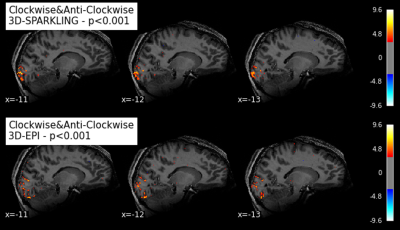 |
80 | Prospects of non-Cartesian 3D-SPARKLING encoding for functional MRI: A preliminary case study for retinotopic mapping
Zaineb Amor1, Chaithya G.R.1,2, Guillaume Daval-Frérot1,2,3, Bertrand Thirion1,2, Franck Mauconduit1, Philippe Ciuciu1,2, and Alexandre Vignaud1
1Université Paris-Saclay, CEA, Neurospin, CNRS, Gif-sur-Yvette, France, 2Université Paris-Saclay, Inria, Parietal, Palaiseau, France, 3Siemens Healthcare SAS, Saint-Denis, France
For the first time, non-Cartesian 3D-SPARKLING (Spreading Projection Algorithm for Rapid K-space sampLING) encoding scheme was used for task-based fMRI (retinotopic mapping) at 7T. Additionally, this new acquisition technique was compared with 3D-EPI, considered as one of the reference acquisition schemes in high-resolution fMRI. The experiment was performed on a single participant at 1mm isotropic and for a temporal resolution of 2.4s. We found that both techniques yield similar statistically significant activation patterns in the visual cortex.
|
||
2452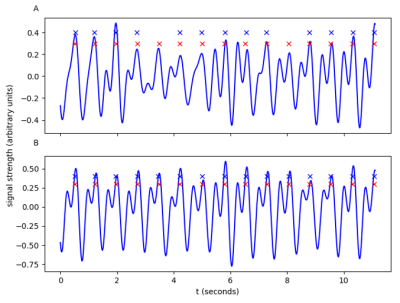 |
81 | Channel Pruning to Improve Robustness of Pilot Tone-based Cardiac Trigger Detection
Jacob Hatef1, Abhishek Vijaykumar1, Chong Chen1, Yingmin Liu1, and Rizwan Ahmad1
1The Ohio State University, Columbus, OH, United States
In this work, we develop and apply a method to prune channels from multi-coil Pilot Tone (PT) data. The method suppresses contributions from noisy or corrupt channels and thus improves the quality of the PT-driven cardiac signal. The method, called Spectrum Optimized Channel pruning (SOC), is based on maximizing the ratio of the signal energy in the frequencies that correspond to physiological motions to the signal energy in the frequencies that are outside the physiological motions. Using data from 15 subjects, we highlight that the proposed channel pruning method improves the quality of the extracted cardiac signal.
|
||
2453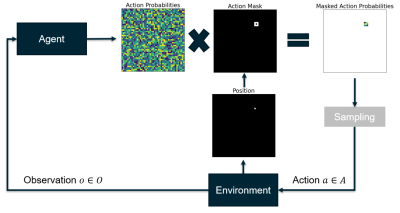 |
82 | Adaptive k-Space Sampling in Magnetic Resonance Imaging Using Reinforcement Learning
Edith Franziska Baader1, Fabian Theißen1, Nicola Pezzotti2,3, and Volkmar Schulz1,4,5,6
1Department of Physics of Molecular Imaging Systems, Institute for Experimental Molecular Imaging, RWTH Aachen University, Aachen, Germany, 2Philips Research, Eindhoven, Netherlands, 3Department of Mathematics and Computer Science, Eindhoven University of Technology, Eindhoven, Netherlands, 4Physics Institute III B, RWTH Aachen University, Aachen, Germany, 5Fraunhofer Institute for Digital Medicine MEVIS, Bremen, Germany, 6Hyperion Hybrid Imaging Systems GmbH, Aachen, Germany
One approach to accelerate MRI scans is to acquire fewer k-space samples. Commonly, the sampling pattern is selected before the scan, ignoring the sequential nature of the sampling process. A field of machine learning addressing sequential decision processes is reinforcement learning (RL). We present an approach for creating adaptive two-dimensional (2D) k-space trajectories using RL and the so-called action space shaping. The trained RL algorithm adapts to a variety of basic 2D shapes outperforming simple baseline trajectories. By shaping the action space of the RL agent we achieve better generalization and interpretability of the agent.
|
||
2454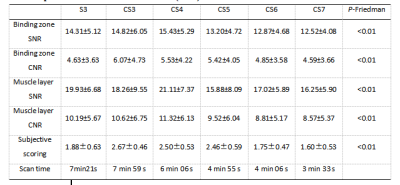 |
83 | Compression sensing based uterine 3D-T2WI isotropic imaging: Optimization of the optimal accelerator Video Not Available
Changjun Ma1, Shifeng Tian2, Lihua Chen2, Nan Wang2, Qingwei Song2, Liangjie Lin3, and Ailian Liu2
1Department of Radiology, the First Affiliated Hospital of Dalian Medical University, Dalian,China, China, 2Department of Radiology, the First Affiliated Hospital of Dalian Medical University, Dalian, China, 3Philips Healthcare, Beijing, China, Beijing, China
3D-ISO-T2WI can obtain ISO volume images compared with traditional 2D-T2WI imaging, reducing partial volume effects, and volume data post-processing can be omni-directional, Three-dimensional, multi-angle display of the overall picture of the uterine structure and the scope of the lesion, but its scanning time is longer [1], the peristalsis of the subject's uterus, bladder and intestine during the scanning time may affect the image quality, and the scanning time The long-term reduction of the patient’s coordination and examination circulation.In this study, different AF will be selected to optimize the best AF based on the CS-based 3D-ISO-T2WI sequence of the uterus.
|
||
2455 |
84 | Single shot multiple overlapping-echo acquisition combined with deep learning for ultra-fast T2 mapping in glioma: A preliminary study Video Not Available
Jianfeng Bao1, Xiaoyue Ma2, Qinqin Yang3, Xiao Wang2, Yong Zhang2, Liangjie Lin4, Jingliang Cheng2, and Congbo Cai3
1The First Affiliated Hospital of Zhengzhou University, Zhengzhou, China, 2Department of Magnetic Resonance Imaging, The First Affiliated Hospital of Zhengzhou University, Zhengzhou, China, 3Department of Electronic Science, Xiamen University, Xiamen, China, 4Philips Healthcare, Beijing, China
Quantitative MRI (qMRI) are expected largely to provide more accuracy clinical diagnostic information. However, bound by the relative long duration for the routine MRI exam and much longer qMRI acquisition time, the qMRI is not widely used for diagnostic purpose. The change of MR signal caused by contrast agent extravasation is affected by many factors, which will increase difficulty in diagnosis. Quantitative MRI (qMRI) are expected to overcome this issue. Recently, an ultra-fast multi-parameters qMRI technique was developed by our group, and herein we aim to apply the proposed strategy on brain tumor imaging and to preliminary access the potential performance.
|
||
The International Society for Magnetic Resonance in Medicine is accredited by the Accreditation Council for Continuing Medical Education to provide continuing medical education for physicians.